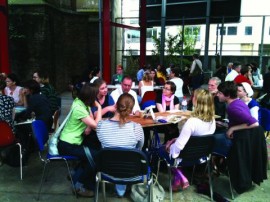
Jobs and opps
Find and advertise work in the visual arts with employer profiles and good practice resources at www.a-n.co.uk/jobs_and_opps
Find and advertise work in the visual arts with employer profiles and good practice resources at www.a-n.co.uk/jobs_and_opps
The recent coverage in a-n publications on good practice and rates of pay for artists is very useful, but I think that an important issue has not been covered.
a-n’s Director of Programmes Susan Jones introduces Good practice in paying artists.
Government enthusiasm for involving young people in arts activities has focused the attention of many galleries. Kate Tregaskis reports from Scotland on recent debates around programmes abroad and raises some questions about good practice.
We are an anonymous grouping of national and international artists who campaign on the working conditions of artists in the UK.
I have recently responded to a couple of exhibition opportunity announcements and followed them through – the most recent: Calling all artists for a group exhibition at The Brick Lane Gallery.
News and updates on AIR’s strategies and activities designed to support professional artists within their practice and working lives.
Current professional development support schemes for visual artists in the UK.
Held in June, ‘Stronger together’ was an opportunity to ‘celebrate and question how we work together’ – exploring collaboration in its many forms – and how vital that is to the survival of the arts.
In March, AIR – Artists Interaction and Representation – put its weight behind calls for art education to be accessible to all, following a survey in which 95% of its members gave hearty support to the view that art education should be accessible “irrespective of background and financial status”. Here we outline AIR’s campaign and the survey’s key findings to provide evidence for artists to use.
“The artist has always occupied a privileged but fragile position in the public eye. For centuries, we have looked to artists across all disciplines to inspire and entertain us, to help us explore the limits of human nature and human possibilities, [and] at times to lead debate and forment revolution.”
Mission Models Money (MMM) has published a seminal guide on collaboration following their in-depth research.
“Things are always changing
So don’t be sad and blue
Change can make you happy
‘Cause it brings you something new”.
(Lyric © Sesame Street)
Commentary arising from research into local authority arts organisers’ needs, aspirations and modus operandi, revealing how they value and engage with artists and the approaches they take to their own professional development and to supporting the environment for contemporary visual arts.
In March 2010, Artichoke Studios was awarded a NAN Go and See bursary in order to visit Dynamic Community Arts in Birmingham and Green Close Studios in Melling. Emilia Telese talks to group member Keith Parkinson about the bursary and its impact on the group.
AIR – Artists Interaction and Representation will later this year be providing a much-needed platform for artists to identify and lead campaigns to improve their professional status and economic conditions, supported by a secondment to AIR from Canadian Artists Representation.
In April, Liverpool-based artist and curator-led group TAXED held an experimental event at A Foundation in Liverpool: TAXED No10: Skillmarket, an exchange for practical skills and useful information.
Launched in 2006,Turning Point is a national ten-year strategy for the visual arts. A network of regional Turning Point groups has since been emerging, each charged with “strengthening the visual arts infrastructure”.
Sadly, a-n’s Director of Development, Louise Wirz, is leaving to explore new territories.
Arts Council England claims that “all our arts policies prioritise strengthening and developing the infrastructure for the artform” – so why, asks Andrew Knight, is the future of Public Art Online under threat?
The quality of art education offered in UK universities has been regularly under the spotlight in recent times. In this month’s Debate, an MA graduate gives an account of the critical situation, and proposes an alternative system to offer education for artists.
Further to the public art commissioning debate that has been published in a-n Magazine since April 2008, artists may be interested to know that the RBS has endorsed the practice of paying for proposals.
Art shows that receive funding as a result of pre-planned conceptual briefs are a common way for exhibitions to occur, and seem suited to budding artists who are eager for experience. They result from a funding body selecting artistic projects […]
Although you may not know it, 2009 has been designated European Year of Creativity and Innovation in recognition that Europe needs to boost its capacity for creativity and innovation, both for social and economic reasons.
Oh dear. Only two pages of opportunity listings this month (a-n Magazine, November 2008) – seven if you count the larger visual impact boxed postings.











